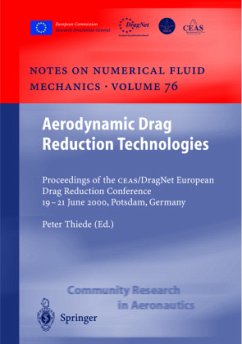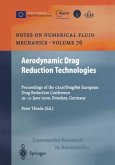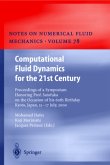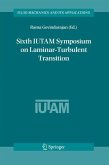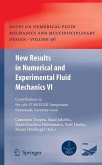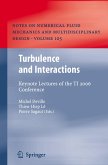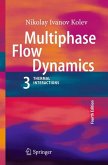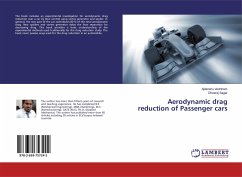Peter Thiede (ed.)Proceedings of the CEAS/DragNet European Drag Reduction Conference, 19-21 June 2000, Potsdam, Germany
Aerodynamic Drag Reduction Technologies
Proceedings of the CEAS/DragNet European Drag Reduction Conference, 19-21 June 2000, Potsdam, Germany
Herausgegeben:Thiede, Peter
Peter Thiede (ed.)Proceedings of the CEAS/DragNet European Drag Reduction Conference, 19-21 June 2000, Potsdam, Germany
Aerodynamic Drag Reduction Technologies
Proceedings of the CEAS/DragNet European Drag Reduction Conference, 19-21 June 2000, Potsdam, Germany
Herausgegeben:Thiede, Peter
- Gebundenes Buch
- Merkliste
- Auf die Merkliste
- Bewerten Bewerten
- Teilen
- Produkt teilen
- Produkterinnerung
- Produkterinnerung
------------------------------------------------------------ This volume contains the Proceedings of the CEAS/DragNet European Drag Reduction Conference held on 19-21 June 2000 in Potsdam, Germany. This conference, succeeding the European Fora on Laminar Flow Technology 1992 and 1996, was initiated by the European Drag Reduction Network (DragNet) and organised by DGLR under the auspice of CEAS. The conference addressed the recent advances in all areas of drag reduction research, development, validation and demonstration including laminar flow technology, adaptive wing concepts, turbulent and…mehr
Andere Kunden interessierten sich auch für
![Aerodynamic Drag Reduction Technologies Aerodynamic Drag Reduction Technologies]() Aerodynamic Drag Reduction Technologies151,99 €
Aerodynamic Drag Reduction Technologies151,99 €![Computational Fluid Dynamics for the 21st Century Computational Fluid Dynamics for the 21st Century]() Mohamed HafezComputational Fluid Dynamics for the 21st Century153,99 €
Mohamed HafezComputational Fluid Dynamics for the 21st Century153,99 €![Sixth IUTAM Symposium on Laminar-Turbulent Transition Sixth IUTAM Symposium on Laminar-Turbulent Transition]() Rama Govindarajan (ed.)Sixth IUTAM Symposium on Laminar-Turbulent Transition151,99 €
Rama Govindarajan (ed.)Sixth IUTAM Symposium on Laminar-Turbulent Transition151,99 €![New Results in Numerical and Experimental Fluid Mechanics VI New Results in Numerical and Experimental Fluid Mechanics VI]() Carmen Tropea / Suad Jakirlic / Hans-Joachim Heinemann / Rolf Henke / Heinz Hönlinger (eds.)New Results in Numerical and Experimental Fluid Mechanics VI151,99 €
Carmen Tropea / Suad Jakirlic / Hans-Joachim Heinemann / Rolf Henke / Heinz Hönlinger (eds.)New Results in Numerical and Experimental Fluid Mechanics VI151,99 €![Turbulence and Interactions Turbulence and Interactions]() Michel Deville / Thien-Hiep Lê / Pierre Sagaut (ed.)Turbulence and Interactions151,99 €
Michel Deville / Thien-Hiep Lê / Pierre Sagaut (ed.)Turbulence and Interactions151,99 €![Multiphase Flow Dynamics 3 Multiphase Flow Dynamics 3]() Nikolay Ivanov KolevMultiphase Flow Dynamics 3116,99 €
Nikolay Ivanov KolevMultiphase Flow Dynamics 3116,99 €![Aerodynamic drag reduction of Passenger cars Aerodynamic drag reduction of Passenger cars]() Ajitanshu VedrtnamAerodynamic drag reduction of Passenger cars27,99 €
Ajitanshu VedrtnamAerodynamic drag reduction of Passenger cars27,99 €-
-
-
------------------------------------------------------------ This volume contains the Proceedings of the CEAS/DragNet European Drag Reduction Conference held on 19-21 June 2000 in Potsdam, Germany. This conference, succeeding the European Fora on Laminar Flow Technology 1992 and 1996, was initiated by the European Drag Reduction Network (DragNet) and organised by DGLR under the auspice of CEAS. The conference addressed the recent advances in all areas of drag reduction research, development, validation and demonstration including laminar flow technology, adaptive wing concepts, turbulent and induced drag reduction, separation control and supersonic flow aspects. This volume which comprises more than 40 conference papers is of particular interest to engineers, scientists and students working in the aeronautics industry, research establishments or academia.
Produktdetails
- Produktdetails
- Notes on Numerical Fluid Mechanics and Multidisciplinary Design 76
- Verlag: Springer / Springer Berlin Heidelberg / Springer, Berlin
- Artikelnr. des Verlages: 978-3-540-41911-2
- 2001
- Seitenzahl: 408
- Erscheinungstermin: 22. Mai 2001
- Englisch
- Abmessung: 260mm x 183mm x 27mm
- Gewicht: 764g
- ISBN-13: 9783540419112
- ISBN-10: 354041911X
- Artikelnr.: 23166731
- Herstellerkennzeichnung Die Herstellerinformationen sind derzeit nicht verfügbar.
- Notes on Numerical Fluid Mechanics and Multidisciplinary Design 76
- Verlag: Springer / Springer Berlin Heidelberg / Springer, Berlin
- Artikelnr. des Verlages: 978-3-540-41911-2
- 2001
- Seitenzahl: 408
- Erscheinungstermin: 22. Mai 2001
- Englisch
- Abmessung: 260mm x 183mm x 27mm
- Gewicht: 764g
- ISBN-13: 9783540419112
- ISBN-10: 354041911X
- Artikelnr.: 23166731
- Herstellerkennzeichnung Die Herstellerinformationen sind derzeit nicht verfügbar.
Session 1 The Challenge of Drag Reduction.- Perspectives for the Future of Aeronautics Research (invited).- The Importance of Aerodynamics in the Development of Commercially Successful Transport Aircraft (invited).- Drag Reduction: A Major Task for Research (invited).- Session 2 Achievements of Technology Demonstration.- Airbus A320 HLF Fin Flight Tests (invited).- Lessons Learned from Dassault's Falcon 900 HLF Demonstrator (invited).- Flight Testing of a HLF Wing with Suction, Ice-Protection and Anti-Contamination Systems.- Session 3 HLF Design & Suction System Integration.- New Aerodynamic Approach to Suction System Design.- Retrofit Studies based on Airbus A310 for HLFC Application on Aircrafts.- Light Transmission Control Technique and Correlation with Pressure Loss Characteristics of Perforated Panels for Hybrid Laminar Flow Applications.- DNS Study of Suction Through Arrays of Holes in a 3-D Boundary-Layer Flow.- Session 4 HLF Operational Aspects.- Saab 2000 In-Service Test of Porous Surfaces for HLFC.- Flight Operational Assessment of Hybrid Laminar Flow Control (HLFC) Aircraft.- Application of HLF Technology to Civil Nacelle (invited).- Session 5 Supersonic Flow Control Aspects.- European Research to Reduce Drag for Supersonic Transport Aircraft (invited).- Attachment Line Transition in Supersonic Flow.- Laminar Design for Supersonic Civil Transport.- Session 6.1 Transition Prediction.- Linear Stability Theory Applied to Natural and Hybrid Laminar Flow Experiments.- Modern Transition Prediction Techniques Based on Adjoint Methods.- Receptivity Processes and Transition Scenarios for Swept-Wing Flows with HFL Technology.- Influence of Acoustic Excitation on 3D Boundery Layer Instabilities.- Session 6.2 HLF Experimental Techniques.- Study of Wind TunnelSimulation Methodology for HLFC Wings.- Transitional Flow Physics and Flow Control for Swept Wings: Experiments on Boundary-Layer Receptivity, Instability Excitation and HLF-Technology.- New Developments in Surface Flow Sensor Technology within the Framework of AEROMEMS.- Session 7 Realisation of Adaptive Wing Concepts.- Aspects of Shock Control and Adaptive Wing Technology (invited).- Drag Reduction on Gurney Flaps and Divergent Trailing Edges.- Next Steps Envisaged to Improve Wing Performance of Commercial Aircraft.- Session 8 Future Prospects.- Industrial Perspectives of Drag Reduction Technologies (invited).- Session 9 Turbulent Drag Reduction Methods.- Current Status and Prospects for Turbulent Flow Control (invited).- Yaw Angle Effects on Optimized Riblets.- Effects on the Resistance and on the Separation of V Shapes Passive Manipulators in a Turbulent Boundary Layer.- Session 10 Separation Control & Induced Drag Reduction.- Active Control of a Laminar Separation Bubble.- Induced Drag Reduction with the WINGGRID Device.- The Lifting System with Minimum Induced Drag.- Poster Session 1.- Assessment of the eN Method as a Transition Prediction Tool for Zero Pressure Gradient Flows with and without Boundery Layer Suction.- Active Control of Nonlinear Disturbances in 2-D Boundary Layers.- Control of the Coherent Vortical Structures of a Boundery Layer.- Novel Approaches to Combat Insect Contamination on HLFC Wings.- Evolutionary Search Algorithms for Boundary Layer Control.- Poster Session 2.- Experimental Investigations on Active and Dynamic Instability Control of Separated Turbulent Wing/Cylinder Flows.- Drag Reduction in Airfoils Using Control Devices in the Shock Wave-Boundary Layer Interaction Region.- Numerical Study of Separation Control by Movable Flaps.
Session 1 The Challenge of Drag Reduction.- Perspectives for the Future of Aeronautics Research (invited).- The Importance of Aerodynamics in the Development of Commercially Successful Transport Aircraft (invited).- Drag Reduction: A Major Task for Research (invited).- Session 2 Achievements of Technology Demonstration.- Airbus A320 HLF Fin Flight Tests (invited).- Lessons Learned from Dassault's Falcon 900 HLF Demonstrator (invited).- Flight Testing of a HLF Wing with Suction, Ice-Protection and Anti-Contamination Systems.- Session 3 HLF Design & Suction System Integration.- New Aerodynamic Approach to Suction System Design.- Retrofit Studies based on Airbus A310 for HLFC Application on Aircrafts.- Light Transmission Control Technique and Correlation with Pressure Loss Characteristics of Perforated Panels for Hybrid Laminar Flow Applications.- DNS Study of Suction Through Arrays of Holes in a 3-D Boundary-Layer Flow.- Session 4 HLF Operational Aspects.- Saab 2000 In-Service Test of Porous Surfaces for HLFC.- Flight Operational Assessment of Hybrid Laminar Flow Control (HLFC) Aircraft.- Application of HLF Technology to Civil Nacelle (invited).- Session 5 Supersonic Flow Control Aspects.- European Research to Reduce Drag for Supersonic Transport Aircraft (invited).- Attachment Line Transition in Supersonic Flow.- Laminar Design for Supersonic Civil Transport.- Session 6.1 Transition Prediction.- Linear Stability Theory Applied to Natural and Hybrid Laminar Flow Experiments.- Modern Transition Prediction Techniques Based on Adjoint Methods.- Receptivity Processes and Transition Scenarios for Swept-Wing Flows with HFL Technology.- Influence of Acoustic Excitation on 3D Boundery Layer Instabilities.- Session 6.2 HLF Experimental Techniques.- Study of Wind TunnelSimulation Methodology for HLFC Wings.- Transitional Flow Physics and Flow Control for Swept Wings: Experiments on Boundary-Layer Receptivity, Instability Excitation and HLF-Technology.- New Developments in Surface Flow Sensor Technology within the Framework of AEROMEMS.- Session 7 Realisation of Adaptive Wing Concepts.- Aspects of Shock Control and Adaptive Wing Technology (invited).- Drag Reduction on Gurney Flaps and Divergent Trailing Edges.- Next Steps Envisaged to Improve Wing Performance of Commercial Aircraft.- Session 8 Future Prospects.- Industrial Perspectives of Drag Reduction Technologies (invited).- Session 9 Turbulent Drag Reduction Methods.- Current Status and Prospects for Turbulent Flow Control (invited).- Yaw Angle Effects on Optimized Riblets.- Effects on the Resistance and on the Separation of V Shapes Passive Manipulators in a Turbulent Boundary Layer.- Session 10 Separation Control & Induced Drag Reduction.- Active Control of a Laminar Separation Bubble.- Induced Drag Reduction with the WINGGRID Device.- The Lifting System with Minimum Induced Drag.- Poster Session 1.- Assessment of the eN Method as a Transition Prediction Tool for Zero Pressure Gradient Flows with and without Boundery Layer Suction.- Active Control of Nonlinear Disturbances in 2-D Boundary Layers.- Control of the Coherent Vortical Structures of a Boundery Layer.- Novel Approaches to Combat Insect Contamination on HLFC Wings.- Evolutionary Search Algorithms for Boundary Layer Control.- Poster Session 2.- Experimental Investigations on Active and Dynamic Instability Control of Separated Turbulent Wing/Cylinder Flows.- Drag Reduction in Airfoils Using Control Devices in the Shock Wave-Boundary Layer Interaction Region.- Numerical Study of Separation Control by Movable Flaps.

